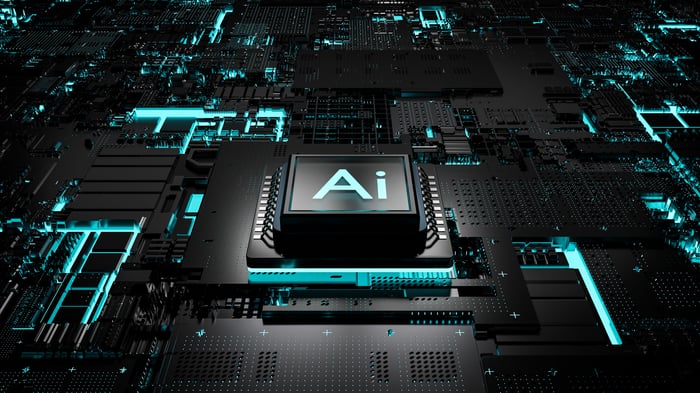Nvidia is no longer the only game in town when it comes to artificial intelligence (AI) hardware.
I’m being fantastic when I tell you to forget it Nvidia (NVDA -0.36%). After all, how can you ignore a stock that grew nearly tenfold in just 18 months and now has a market cap of $3.1 trillion, which is 6.7% of the total S&P 500 index? Not to mention, the company’s chips are the driving force behind artificial intelligence (AI).
However, the incredible run in Nvidia’s stock made it quite expensive, even compared to its expected earnings in a few years. Nvidia isn’t the only chipmaker reaping the rewards of AI, so investors may find better value in other stocks in this space.
Micron Technology (MU -0.53%) is one to consider. The vast majority of analysts followed by The Wall Street Journal Give it the highest possible buy rating, with none recommending sell. That is why.

Image source: Getty Images.
Micron is catching a tailwind from AI
Nvidia’s graphics processing units (GPUs) are critical to AI development. However, memory chips are a key component of those GPUs. They essentially give AI models short-term memory, storing data in a ready state where it can be called up immediately either for training purposes or when a user requests a chatbot.
Micron makes the world’s leading HBM3E (HBM stands for High Bandwidth Memory) for the data center. The HBM3E architecture offers higher bandwidth than previous memory generations (such as DDR), while occupying a smaller physical footprint that also consumes less power. This means mountains of data can be transferred faster while reducing electricity costs. Both factors are top of mind for data center operators.
Micron’s HBM3E is so efficient that Nvidia is using it in its latest GPUs, including the new H200, which can infer AI models (ingest live data and make predictions) twice as fast as the H100.
During the last fiscal 2024 third quarter (ended May 30), Micron said HBM data center solutions contributed $100 million in revenue. The company expects total HBM revenue to be in the hundreds of millions of dollars at the close of fiscal year 2024 (ending Aug. 31) and several billion dollars in fiscal year 2025. In fact, Micron’s entire supply is completely sold out for the year next year already.
But Micron’s AI opportunity doesn’t stop in the data center, because AI-enabled personal computers (PCs) require up to 80% more memory capacity (DRAM) than traditional PCs. says Micron MicrosoftThe new Copilot+ AI PC comes with a minimum DRAM content of 16GB, while the previous generation came with an 8GB option. Similarly, AI-enabled smartphones require up to twice the memory capacity of their predecessors.
These trends will lead to more money for Micron.
Micron’s revenue is growing, thanks to AI
Micron generated $6.8 billion in revenue during the third quarter, representing an 81% year-over-year increase. This marked an acceleration from the previous quarter when revenue grew by 57%, which speaks to how quickly demand for AI is growing.
Beneath the surface of the headline number, the results were even more impressive. Micron’s computing and networking (data center) business, which is the largest of its four segments, grew revenue by 85% last year. Its mobile segment expanded even faster, with revenue rising 94% as the world’s leading smartphone makers race to integrate AI into their flagship devices.
Micron also delivered a strong bottom line. It generated $0.30 in earnings per share during the third quarter, which was a big swing from $1.73. loss per share from the period of the previous year. It was also above management’s guidance high of $0.24.
As I mentioned earlier, the supply of products like the HBM3E is now sold out until the end of 2025, and these supply constraints give Micron the ability to charge higher prices. This translates into improved profitability in the third quarter, and this tailwind should continue at least next year.
Wall Street is very bullish on Micron stock
Shares of Micron are up 72% so far this year and are trading near all-time highs, but that hasn’t deterred Wall Street. The Wall Street Journal tracks 38 analysts who cover the stock, and 27 give it the highest possible buy rating. Seven others are overweight (bullish camp), and two recommend holding. Although two analysts have assigned Micron an underweight (underweight) rating, neither is recommending an outright sell.
Micron’s 2024 fiscal year ends in August. Its earnings bottom line will be hurt by weakness at the start of the year stemming from an inventory glut in its consumer-oriented segments. But analysts have already turned their attention to fiscal 2025, when they expect Micron to deliver $9.06 in earnings per share — based on the stock’s June 26 closing price of $142.36, which puts it at a previous price-to-earnings (P/E) ratio of just 15.7.
For perspective, iShares Semiconductor ETF trades at a P/E ratio of 35.9 today, implying that Micron’s stock would need to double within the next year just to trade in line with its peers in the chip industry (assuming Wall Street’s earnings forecast is correct). Plus, Nvidia trades at a forward P/E ratio of 46.6, which makes Micron stock look like an even better value.
Since Micron’s HBM3E memory is a key component in many of Nvidia’s latest GPUs, any investor who thinks Nvidia will do well should also consider adding Micron to their portfolio, especially at the current price .
Anthony Di Pizio has no position in any of the stocks mentioned. The Motley Fool has positions in and recommends Microsoft, Nvidia and the iShares Trust-iShares Semiconductor ETF. The Motley Fool recommends the following options: long January 2026 $395 Microsoft calls and short January 2026 $405 Microsoft calls. The Motley Fool has a disclosure policy.